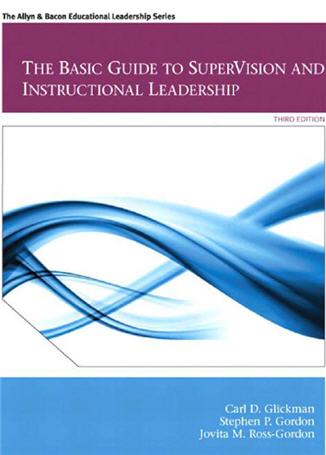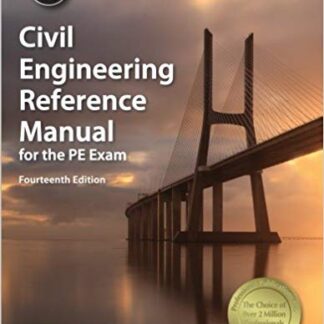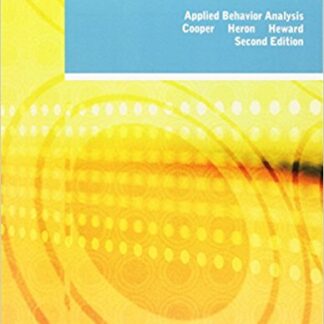Description
The Basic Guide to SuperVision and Instructional Leadership 3rd Edition by Carl D. Glickman, ISBN-13: 978-0132613736
[PDF eBook eTextbook] – Available Instantly
- Publisher : Pearson; 3rd edition (January 29, 2012)
- Language : English
- 384 pages
- ISBN-10 : 0132613735
- ISBN-13 : 978-0132613736
NOTE: This eBook is a standalone eBook and will not include any access codes.
A comprehensive guide for aspiring school supervisors and instructional leaders.
Table of Contents:
Preface
New to This Edition
MyEdLeadershipLab™
Contents
Part 1 Introduction
Chapter 1 SuperVision for Successful Schools
SuperVision: A New Name for a New Paradigm
Supervisory Glue as a Metaphor for Success
Organization of This Book
Supervision and Moral Purpose
MyEdLeadershipLab™
References
Part 2 Knowledge
Chapter 2 The Norm: Why Schools are as they are
The Work Environment or Culture of Schools
The Legacy of the One-Room Schoolhouse
Isolation
Psychological Dilemma and Frustration
Routine of the Teaching Day
Inadequate Induction of Beginning Teachers*
Inadequate Resources.
Difficult Work Assignments.
Unclear Expectations.
Sink-or-Swim Mentality.
Reality Shock.
Effects of Environmental Difficulties.
Inequity
Unstaged Career
Lack of Dialogue about Instruction
Lack of Involvement in Schoolwide Curriculum and Instructional Decisions
Lack of a Shared Technical Culture
Conservatism
Blaming the Victim and Structural Strain
Viewing School Culture in the Context of the Larger Culture
MyEdLeadershipLab™
References
Chapter 3 The Exception: What Schools can be
Early Effective Schools Research
The Second Wave of Effective Schools Research
Context Studies in Effective Schools Research
Has Effective Schools Research Outlived Its Usefulness?
The Legacy of Effective Schools Research
From Effective Schools to School Improvement
A Cause beyond Oneself
Connecting School Improvement to the Local Community and Larger Society
MyEdLeadershipLab™
References
Chapter 4 Adult and Teacher Development within the Context of the School: Clues for Supervisory Practice
Adults as Learners
Intelligence and Wisdom
Theories of Adult Learning
Andragogy.
Self-Directed Learning.
Transformational Learning.
Experience and Learning: Situated Cognition, Informal and Incidental Learning
Holistic Adult Learning
Critical Perspectives on Adult Learning
Teachers as Adult Learners
Adult and Teacher Development
Stage Theories of Adult and Teacher Development
Cognitive Development.
Conceptual Development.
Moral Development.
Ego Development.
Levels of Consciousness.
Stages of Concern.
Integrating Stage Development Theories.
Life Cycle Development, Teachers’ Life Cycles, and the Teaching Career
Transition Events
Role Development
Beyond Universal Conceptions of Development: The Sociocultural Context of Adult Development
The Role of Gender in Adult Development.
The Role of Race and Ethnicity in Adult Development.
Review of Adult/Teacher Development Models
MyEdLeadershipLab™
References
Chapter 5 Reflections on Schools, Teaching, and SuperVision
Effective and Good Schools: The Same?
Instructional Improvementand Effective Teaching
Beliefs about Education
Supervisory Beliefs
Supervisory Platform as Related to Educational Philosophy
Essentialism
Experimentalism
Existentialism
Checking Your Own Supervisory Beliefs
Approach A.
Approach B.
Approach C.
Approach D.
Response.
Interpretation.
Approach A.
Approach B.
Approach C.
Approach D.
Response.
Interpretation.
What Does Your Belief Mean in Terms of Supervisor and Teacher Responsibility?
Where You Stand Depends on Where You Sit: Effects of Culture on Beliefs
MyEdLeadershipLab™
References
Part 3 Interpersonal Skills
Chapter 6 Supervisory Behavior Continuum: Know Thyself
Outcomes of Conference
Valid Assessment of Self
Johari Window
Cognitive Dissonance
Comparing Self-Perceptions with Others’ Perceptions
Comparing Self-Perceptions to Recorded Behaviors
Directions for Completing:
Section A: Professional Characteristics
Section B: Skills
Section C: Individual Assistance
Section D: Schoolwide Assistance
Directions for Scoring:
MyEdLeadershipLab™
References
Chapter 7 Directive Control Behaviors
Directive Control Continuum of Behaviors
A History of Overreliance on Control
When to Use Directive Control Behaviors
Moving from Directive Control toward Directive Informational Behaviors
Directions:
Teacher Description and Situation:
Critical Reflection on Directive Control Supervision
MyEdLeadershipLab™
References
Chapter 8 Directive Informational Behaviors
Directive Informational Continuum of Behaviors
Comparing Directive Control andDirective Informational Statements
When to Use Directive Informational Behaviors
Moving from Directive Informationaltoward Collaborative Behaviors
Directions:
Teacher Description and Situation:
Critical Reflection on DirectiveInformational Supervision
MyEdLeadershipLab™
References
Chapter 9 Collaborative Behaviors
Collaborative Continuum of Behaviors
Issues in Collaborative Supervision
When to Use Collaborative Behaviors
Directions:
Teacher Description and Situation:
Moving from Collaborative toward Nondirective Behaviors
Critical Reflectionon Collaborative Supervision
MyEdLeadershipLab™
Chapter 10 Nondirective Behaviors
Nondirective Continuum of Behaviors
Initiating Nondirective Supervision
Nondirective, Not Laissez-Faire, Supervision
Issues with Nondirective Supervision
When to Use Nondirective Behaviors
Directions:
Teacher Description and Situation:
Critical Reflection on Nondirective Supervision
MyEdLeadershipLab™
References
Chapter 11 Developmental SuperVision: Theory and Practice
Rationale for Developmental Supervision
The Problem of Variability
Supervision for Teacher Development
Applying Developmental Supervision
Phase 1: Choosing the Best Approach
Phase 2: Applying the Chosen Approach
Phase 3: Fostering Teacher Development
Not Algorithms, but Guideposts for Decisions
Scenario and Discussion: Inappropriate Use of Interpersonal Behaviors?
MyEdLeadershipLab™
References
Part 4 Technical Skills
Chapter 12 Assessing and Planning Skills
Assessing and Planning within the Organization
Ways of Assessing Need
Eyes and Ears
Systematic Classroom and School Observations
Official Records
Review of Teacher and Student Work Products
Third-Party Review
Written Open-Ended Survey
Check and Ranking Lists
Delphi Technique
Nominal Group Technique
Analyzing Organizational Needs
Cause and Effect Diagrams
Flowcharts
Pareto Charts
Planning
Affinity Diagrams
Impact Analysis Charts
Gantt Charts
Force Field Analysis
Cautions Concerning Planning
MyEdLeadershipLab™
References
Chapter 13 Observing Skills
Formative Observation Instruments Are Not Summative Evaluation Instruments
Ways of Describing
Quantitative Observations
Categorical Frequency Instrument
Performance Indicator Instruments
Visual Diagramming
Qualitative Observations
Verbatim and Selected Verbatim
Detached Open-Ended Narrative
Participant Open-Ended Observation
Focused Questionnaire Observation
Tailored Observation Systems
Types and Purposes of Observation
Cautions Concerning Observations
MyEdLeadershipLab™
References
Chapter 14 Evaluation Skills
Judgments
Key Decisions in the Program Evaluation Process
What Is the Purpose of the Evaluation?
Who Performs the Evaluation?
What Questions Must Be Answered?
What Data Is Gathered and How?
How Are the Data Analyzed?
How Is the Evaluation Reported?
Overall Instructional Program Evaluation
Phase One: Selecting Areas to Be Examined
Phase Two: Identifying Specific Evaluation Questions
Phase Three: Designing the Evaluation
Phase Four: Gathering and Analyzing Data
Phase Five: Preparing and Presentingthe Evaluation Report
Program Evaluation and Teacher Empowerment
Teacher Evaluation
Comparing Summative and Formative Teacher Evaluation
Why Summative and Formative Teacher Evaluation Should Be Separate
How to Separate Summativeand Formative Evaluation
Self-Evaluation
MyEdLeadershipLab™
References
Part 5 Technical: Tasks of SuperVision
Chapter 15 Direct Assistance to Teachers
Clinical Supervision
Step 1: Preconference
Step 2: Observation
Step 3: Analysis and Interpretation
Step 4: Postconference
Step 5: Critique
Comparing Clinical Supervisionwith Teacher Evaluation
Integrating Clinical Supervision and Developmental Supervision
Peer Coaching
Purpose
Preparation
Scheduling
Troubleshooting
Other Forms of Direct Assistance
Improving Classroom Culture
MyEdLeadershipLab™
References
Chapter 16 Group Development
Dimensions of an Effective Group
Group Member Roles
Task Roles
Person Roles
Dysfunctional Roles
Dealing with Dysfunctional Members
Resolving Conflict
Context.
Scene 1 (10 minutes).
Scene 2 (10 minutes).
Scene 3 (10 minutes).
Whole-Group Processing (10 minutes).
Context.
Scene 1: Wrong Way (10 minutes).
Scene 2: Right Way (10 minutes).
Whole-Group Processing (10 minutes).
Preparing for Group Meetings
Agendas
Establishing Ground Rules
Guided Discussion
MyEdLeadershipLab™
References
Chapter 17 Professional Development
Characteristics of Successful Professional Development Programs
Integrating Schoolwide, Group, and Individual Professional Development
Alternative Professional Development Formats
Examples of Effective Professional Development Programs
Districtwide Professional Development
School-Based Professional Development
Individualized Professional Development
Stages of Professional Development
The “Nuts and Bolts”
Extending the Concept of Professional Development
Evaluating Professional Development Programs
Teachers as Objects or Agentsin Professional Development
MyEdLeadershipLab™
References
Chapter 18 Curriculum Development
Sources of Curriculum Development
Legislated Learning
State-Mandated Curriculum
High-Stakes Tests and the Curriculum
Curriculum Development as a Vehiclefor Enhancing Collective Thinkingabout Instruction
What Should Be the Purposeof the Curriculum?
What Should Be the Contentof the Curriculum?
How Should the Curriculum Be Organized?
In What Format Should the Curriculum Be Written?
Behavioral–Objective Format
Webbing
Results-Only Format
Curriculum Format as Reflectiveof Choice Given to Teachers
Relationship of Curriculum Purpose,Content, Organization, and Format
Levels of Teacher Involvementin Curriculum Development
Example Level I: Imitative Maintenance
Example Level II: Mediative
Example Level III: Creative–Generative
Integrating Curriculum Format with Developers and Levels of Development
Matching Curriculum Developmentwith Teacher Development
The Curriculum and Cultural Diversity
MyEdLeadershipLab™
References
Chapter 19 Action Research: The School as the Centerof Inquiry
How Is Action Research Conducted?
A Developmental Approach to Action Research
Action Research: Vehicle fora Cause beyond Oneself
Example of Action Research
Expanding Boundaries: Alternative Approaches to Action Research
Interpretive Action Research
Critical Action Research
Shared Governance for Action Research
Premises
Principles
Operational Model
The Formal Groups.
Decision-Making Procedures.
Implementation.
Suggestions for Assisting Action Research
Conclusion: Focus, Structure,and Time for Development
MyEdLeadershipLab™
References
Part 6 Cultural Tasks of SuperVision
Chapter 20 Facilitating Change
Education Change Theory
Capacity
Commitment
Leadership
Evolutionary Planning
Problem Solving
Support
Coherence
School Cultures of Continuous Improvement
Change at the Individual Level
Changing the Conditions of Teaching
MyEdLeadershipLab™
References
Chapter 21 Addressing Diversity
Achievement Gaps among Economic,Racial, and Ethnic Groups
A Societal or a School Problem?
Cultural Clashes
Culturally Responsive Teaching
Culturally Responsive Schools
Teacher Development
School Development
Collaboration with Familiesand the Community
Gender Equity
Equity for Sexual Minorities
Overarching Patterns
Connecting the Technical Tasks of Supervision to Cultural Responsiveness
MyEdLeadershipLab™
References
Chapter 22 Building Community
Democratic Community
Moral Community*
Care
Wholeness
Connectedness
Inclusion
Justice
Peace
Freedom
Trust
Empowerment
Professional Learning Community
Community of Inquiry
Engagement with the Larger Community
School-Based and School-Linked Community Service
Community Development
The Community as a Learning Environment
Service Learning.
Place-Based Learning.
Democratic Learning.
Five Attributes, One Community
Conclusion
MyEdLeadershipLab™
References
Appendix A Review of Interpersonal Behavior in the Four Supervisory Approaches
Name Index
What makes us different?
• Instant Download
• Always Competitive Pricing
• 100% Privacy
• FREE Sample Available
• 24-7 LIVE Customer Support






